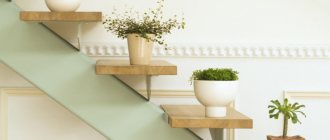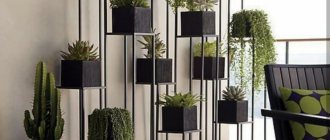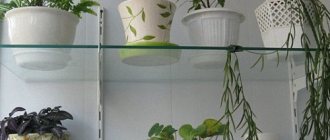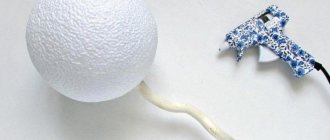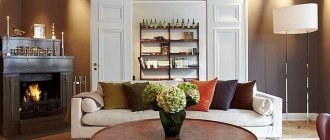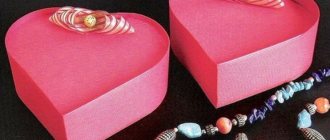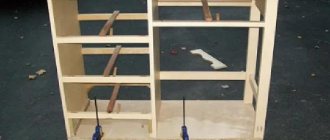Classics of the genre
The chaos of flower pots is a sad sight, regardless of whether they stand on the windowsill or on the chest of drawers. In order for green spaces to look decorative and not burden the interior, a well-thought-out concept is needed. First, select the plants that you like best, and then build a display with interesting flower pots. However, you can plant flowers beautifully in ordinary plastic pots - the main thing is that their color matches other interior elements.
Photo: amazon.co.uk
Pot shapes
Each plant has its own root system. For example, in cacti, palm trees and citrus fruits it is quite long and goes deep into the soil. Begonias, geraniums and chrysanthemums have fibrous, branched roots located near the soil surface. The flower pot must be chosen taking into account these features so that the plant develops normally. If the roots are long, then it is better to take a narrow and high container. If they are fibrous, then shallow and wide pots are more suitable. If the store does not have the ideal bowl, you can opt for a universal option. These are standard containers whose top diameter matches the height. As a rule, most flowers do well in them.
It is not recommended to buy models with futuristic and intricate shapes. It is difficult to replant a plant from them without causing damage to the root system.
Simple and beautiful
Calculate the exact cost of repairs using an online calculator
and receive a free detailed estimate for repairs
Calculate
When creating an unusual composition of indoor plants on the windowsill, you should not take assorted flower pots. It’s better to let them be the same in color and material, but different shapes. By the way, you need to adhere to such a plan when landscaping the entire interior, and not just the window sill.
Photo: pricearchive.org
Plastic or ceramics, which pot to choose?
There are many pots on the market made in different styles and from different materials. Today we will look at flowerpots made of plastic and ceramics and determine which material is better for indoor flowers.
Plastic pot
The material appeared relatively recently, in the twentieth century. Products made from this material have gained leading positions among gardeners. They are distinguished by reasonable price, lightness and variety of shapes.
Some designers have developed fashionable plastic pots with an unusual pattern that are illuminated from the inside. They especially highlight the beauty of flowers.
Minuses. It is worth remembering that cheap plastic is toxic and can harm the flower. Also, this material does not breathe, does not allow moisture to pass through, and is quite fragile. Drainage is often placed at the bottom of such pots to prevent water from stagnating in the roots.
Ceramic pot
One of the oldest materials used by mankind. Products made from this raw material are considered classics. They cost more, but the demand for them is no less than for plastic. Among the advantages of the products, environmental friendliness stands out.
Minuses. Ceramic pots are covered with glaze. They look fashionable, but their walls do not allow air and moisture to pass through. Therefore, for many cultures such flowerpots can only be decorations. You also need to consider the risk of purchasing low-quality counterfeits.
Which pot is right for you - decide for yourself. The main thing is to weigh the pros and cons. It is better to opt for more expensive material. Remember that the future of the plant, its health and growth depend on the choice of flowerpot material.
When thinking about how to choose a flower pot, you need to be guided first of all by important rules. Typically, they consist of promoting optimal plant development.
Remember, when buying pots, they must have a drainage hole, smooth walls without grooves or depressions.
Be sure to buy a pallet in the form of a disk or with low sides. The volume and shape of the pot is an individual matter and is selected separately for a specific plant, depending on the size of its roots.
Magic of light
For the latest romantics and lovers of a warm lamp atmosphere, luminescent flower pots will be a godsend. Such luminous flowerpots will serve you not only for their intended purpose - they will create a magical atmosphere in the room at night, no worse than a night light.
Photo: privatehomes.com
Photo: gartenplanet.de
Family photo
What if you decorate old flower pots with family photos? For example, decorate each pot with photographs of all family members - you will get the original composition “Mom, Dad, Me - a flower family.” Choose a “green hairstyle” for everyone - and you’ll get a real floral masterpiece. In addition, with this approach, you can teach your household to care for flowers - after all, if you don’t water your hair, it will begin to fade.
Photo: archicoutureblog.com
High technologies at the service of florists. Unusual flower pots
As in all areas of our lives, progress does not stand still, so in floristry more and more new materials and technologies are constantly appearing. This is especially true for dishes for house plants. Original flower pots with additional functions can now be purchased not only in specialized places, but also in supermarkets or small shops. What do inventors offer us?
Pots and flowerpots with automatic watering
Such containers for house plants are very convenient for busy and forgetful people, as well as for those who often leave home. Using auto-watering technology, you don’t have to worry about frequently watering your flowers and only occasionally replenish the water in a special tank.
There are several options for pots and flowerpots that use self-watering technology:
Ceramic pots with automatic watering.
One of the properties of clay - its porous structure - is used for flower containers with automatic watering. In the middle of the pot there is a reservoir into which water is poured. If the soil dries out, the reservoir allows enough water for the plant to pass through. If the ground is well moistened, water does not enter the soil. This version of automatic watering was developed and implemented by industrial designer from the USA Joey Roth.
Plastic pots with automatic watering.
Plastic bowls with automatic watering usually consist of two containers inserted into one another, with the plant being planted in the smaller one (inner container). There is a fairly large gap between the containers into which water is poured. Through the bottom, water in the required quantity enters directly into the soil to the roots of the plant.
Manufacturers of such dishes promise that plants planted in them can be left without watering for two weeks to three months. The only drawback is that the automatic watering system only works if the plant is mature and has a voluminous rhizome (if the root of the plant is not developed and is located at the surface of the soil, it will not receive enough moisture, since the water for irrigation comes from below) Young plants must be watered in the traditional way .
Automatic watering technology in flower pots
Florariums, paludariums
Florariums (glass containers for growing plants) and paludariums (large florariums suitable for several groups of plants) are becoming increasingly popular among exotic lovers.
Plants in florariums look very impressive and are a real decoration of the interior. However, there are several limitations that an experienced florist should keep in mind:
1. There are only a small number of houseplant species that can grow in a glass container. These are mainly succulents, anubias, some mosses and ferns 2. The glass walls of the florarium greatly enhance the power of sunlight and can cause leaf burns. That is why it is not recommended to place such compositions in direct sunlight 3. Florariums and paludariums are quite complex systems and require increased care
Pots with lighting
One of the most spectacular new products of recent times is interior flower pots with lighting. Typically, such flowerpots are made of matte translucent plastic, between the walls of which there are luminous elements. The power source for the pots is electricity or built-in batteries. Inside the flowerpot you can place a container with a plant.
Pots with lighting look great both indoors and on outdoor terraces, being both a landscaping element and an additional source of light.
Silicone pots
The idea of creating silicone containers for growing flowers came to the mind of the young Italian designer Emanuele Pizzolorusso at a time when he was observing the process of collecting garbage in plastic bags. The designer noticed that to make it easier to fill the bags, workers bend their edges, thus changing the volume of the plastic container. The artist decided to translate this principle into the production of containers for house plants and created silicone pots that can change size as the plant grows. Thanks to the flexibility of silicone, the edge of the pot can be bent and the height of the bowl can be reduced. When the flower grows, you need to return the edge to its place and the pot will become tall again. Since the silicone used to make the bowls is quite dense, the container holds its shape well and does not deform.
Symbiosis of plants and interior items
Why use free-standing pots when you can integrate them into tables, benches, shelves and even wall tiles - this idea has occurred to many designers. The result was very interesting and practical pieces of furniture and interior design, combining several functions.
Perhaps the only disadvantage of such systems is the difficult planting and care of plants, which is why you should choose only the most unpretentious specimens for planting.
Metallic shine
Metal hanging pots will automatically make even the most neutral and laconic interior stylish. If your home lacks copper or silver shine, take note of this option. Moreover, metal is back in trend today.
Photo: housebeautiful.com
How to make a flower pot or flowerpot with your own hands
If you prefer things made by yourself, try your hand at the art of making flower pots and plant pots.
Making a pot at home is somewhat more difficult than decorating a flowerpot, but it is quite possible, and the result will certainly please you.
DIY pots made of plaster and concrete
What you will need: cement-sand mixture or plaster, water, two plastic or wooden molds of the same shape, but different volumes
Thoroughly mix the gypsum or cement-sand mixture with water, in a ratio of 1:1 (gypsum-water) or 1:3:2 (cement-sand-water). Prepare plastic (wooden) molds - grease the inside of the larger container and the outside with less oil. , grease or green soap. This step is necessary so that the mold can be easily separated from the cement or plaster later. Pour concrete (gypsum solution) into the bottom of the larger container, let it harden a little, then place the smaller container on top and lightly press it down with your hands. Carefully pour the remaining concrete or plaster into the gap formed between the walls of the molds. Wait for the mixture to completely harden and carefully remove the plastic molds. At the bottom of the resulting pot, drill several holes for water drainage.
Pots made of vines or brushwood . Wicker weaving is a real art, sometimes only accessible to professionals. But an ordinary person can also try his hand at wicker weaving, making, for example, a flower pot. What you will need: dry thin twigs (vine), base mold, thin wire, burlap, glue Clean the twigs, remove excess shoots. Take the base and, following the shape, braid it in a circle with the prepared branches. You don’t have to adhere to a strict pattern; intertwine the twigs randomly, from time to time fastening them with wire for rigidity. Then remove the mold and glue thick burlap inside the finished product. The resulting container can be used both as a flowerpot and as a pot for orchids.
Coconut pots . These pots are perfect for small house plants.
What you will need: coconut, hacksaw or grinder, awl or other sharp object
Choose a round coconut if you want a stable shape or an elongated oval nut if the composition with the plant will be hanging. Make holes with an awl in the places of three small depressions on the “butt” of the coconut and remove the liquid. Subsequently, excess water will drain through these holes when watering the plant. Saw off the opposite end of the coconut with a hacksaw, stepping back about one-third from the edge. Thoroughly clean the inside of the nut, removing the white edible mass. The pot is ready. If you drill additional holes on the sides of the nut, you can thread a cord through them and hang it.
Vinyl record pots . Original and functional pots are made from old vinyl records.
What you will need: vinyl records, gas or electric stove, rope, thick cotton gloves, acrylic paints, plastic primer
Thread a rope through the existing hole in the plate and secure it with a knot or metal nut so that the plate hangs freely on the rope. Preheat the stove and hold the plate above it for several minutes at a distance of 20-30 cm. Hold the plate by the rope and use gloves - hot air can burn the skin. After some time, exposure to hot air will make the plate soft. At this point, you can give the vinyl disc any desired shape, either by hand or by placing it on some kind of frame. After the vinyl has cooled and hardened again, you can paint the resulting pot with acrylic paint. For better adhesion of paint to the plate, you can use plastic primer.
***
As you can see, there are many ways to make a flower pot with your own hands, you just need to show a little imagination. Well, in the next article we will talk about decorating plant pots.
Vertical gardening
It is not necessary to allocate a window sill for indoor plants. They can be placed vertically. Flowers in wall pots will be a worthy replacement for an expensive painting.
Photo: homewowdecor.com
Photo: home-designing.com
Charming miniatures
These cute little pots are sure to make you smile. A great idea for landscaping in a nursery's interior. Whether it's mini humans, a family of kittens, or a robot superhero, your little ones will love them!
Photo: home-designing.com
Photo: home-designing.com
Aquafarm
And this is not just a flower pot, this is a real ecosystem. Plants live beautifully in one part of it, and fish swim in the other. What you need for eco-style interiors. However, such potted decor will take root in any other modern interior.
Photo: thegadgetflow.com
Flower pots and flowerpots as an interior element
One of the most important factors when choosing flower pots and flowerpots is the compatibility of the design of the plantware with the design and style of the interior of the room. Such a seemingly small thing - a flower pot - can decorate your living room, bedroom or kitchen, and vice versa. To ensure that the container with the plant does not look like a foreign object in your interior, follow a few simple rules:
1. Pots or flower pots with flowers must fully match the style of the entire room as a whole. For example, a flower pot with a laconic and simple design will fit perfectly into a room decorated in Japanese, high-tech or minimalist style. A richly decorated bowl with monograms and reliefs is perfect for a classic or baroque interior. And bright pots with cheerful designs would be appropriate in a nursery.
2. In order for the container with the plant to fit successfully into the existing interior, it is necessary to pay attention to its color design. If you want plants to be an accent spot in the interior, choose pots in rich, contrasting colors. Alternatively, the color of dishes with plants can overlap with other bright details: sofa cushions, posters, textiles, and so on.
In contrast to contrasting compositions, there is nuance. The technique is suitable in a situation where there is no need to highlight the floral dishes. In this case, the color of the bowls should match the main interior color, for example the color of the walls.
3. If plants are arranged in groups or in a row indoors, the containers in which they are grown must be compatible with each other. This rule applies to all flower containers located in the same room.
The simplest and most win-win option, applicable if the plants are the same in size, is to use pots of the same shape and size.
However, if you want variety, some combination is possible. For example, in the case where plants in a room are of different sizes, pots of different capacities, but of the same color, would look good. You can also place several multi-colored flowerpots of the same shape. At the same time, the palette of floral dishes should organically fit into the palette of the existing interior. It is easy to pick up flower pots or flowerpots from one collection in specialized florist shops or supermarkets.
More complex combinations of shapes and colors require a professional approach and consultation with an interior designer.
4. When decorating the interior of a room with plants, do not forget about non-traditional solutions, such as hanging or free-standing pots or cache-pots. This option for placing flowers is perfect if there are not enough horizontal surfaces or you don’t want to clutter them up too much.
For hanging and free-standing pots, ampelous (climbing and hanging) plants are usually recommended, but, in fact, almost any type of houseplant fits perfectly in containers of this type. The only exceptions are, perhaps, very large and massive specimens (palm trees, ficus, monstera, zamioculcas, etc.).
5. When choosing the palette of a flower pot, you need to take into account the color of the plant placed in it. For example, non-flowering plants can be placed in pots of bright colors. Conversely, bright dishes, the rich shade of which conflicts with the color of the flower, look inharmonious. In this case, pots in neutral shades will be appropriate, which will perfectly highlight the beauty of a flowering plant: white, gray, beige, terracotta, coffee.
If you still want a riot of colors, pay attention to the combination of shades of the flower of the plant and the pot. A few examples of what designers consider unsuccessful combinations:
- soft pink flowers and a bright red, yellow or orange pot
- delicately colored silver-green or pink-green foliage and deep green pot
- plants with a pronounced pattern on the leaf blade and a green pot
Tableware design
For houseplants with a shallow root system, even ordinary mugs, sugar bowls, and milk jugs can become an excellent home. For larger flowers, it is better to use other kitchen utensils, such as a teapot or jug. A great idea for a Provence style kitchen or loggia decor.
Photo: homedit.com
How to choose a flowerpot
We have already found out above that the plant is not planted directly in flowerpots, which is why there are no strict criteria when choosing flowerpots. There are only two parameters worth noting: the size of the flowerpot and the material from which it is made.
The dimensions of the pots depend only on the size of the container directly into which the houseplant is planted. In order to choose a suitable flowerpot, before purchasing, use a ruler to determine the height, diameter of the lower and upper rings of the flower bowl, and then add 1-2 cm to these measurements in each dimension. The resulting numbers will be the size of the flowerpot you need.
As for the materials from which the flower pots are made, you can focus on their utilitarian properties and your taste. So, for example, a flowerpot made of plastic is light and durable, while a flowerpot made of glass or ceramics is heavy and fragile.
Old things
Every woman probably has a pair of favorite shoes that she can no longer wear and would be a pity to throw away. Have your Louboutins become unusable? Involve them in landscaping your home. These shoes will give your indoor plants a stunning look!
Photo: homestratosphere.co
